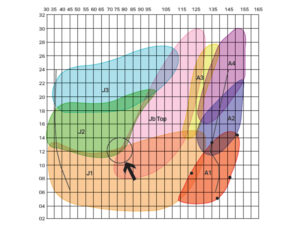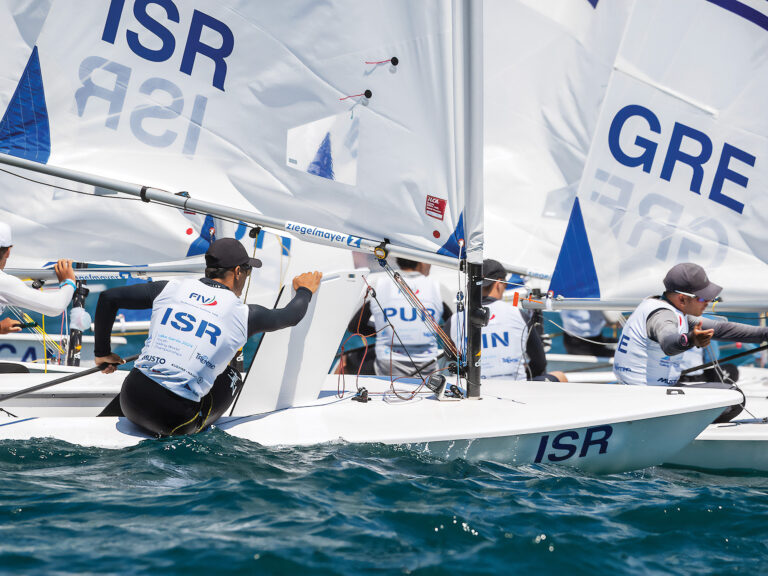
New Rules 1
Editor’s note: Interpretations and opinions expressed in the following article, originally published in Sailing World, are those of the author. This material may not be republished without permission of the author. To obtain an official US Sailing interpretation of a racing rule, you must follow the process set out in Rule 70.3 and Appendix F in the US Sailing Rulebook. The 2005-2008 edition of The Racing Rules of Sailing begins to apply on January 1, 2005 (until then the 2001-2004 rules remain in effect). If you don’t have a copy of the new edition of the rulebook in your hands, an electronic version is available on the International Sailing Federation’s website (www.sailing.org). January 1 will come sooner than you think so now’s the time to grasp any important changes. In this and subsequent columns I will discuss the differences between the 2001-2004 and the 2005-2008 editions. Let’s start by looking at changes in Part 2-rules that apply when boats meet. Rule 13-While Tacking The phrase “or the one astern” has been added to the last sentence of this rule. With the addition, the rule now reads: “After a boat passes head to wind she shall keep clear of other boats until she is on a closehauled course. During that time, rules 10, 11, and 12 do not apply. If two boats are subject to this rule at the same time, the one on the other’s port side or the one astern shall keep clear.” With addition of “or the one astern,” Rule 13 now covers the following specific and unusual situation. While reaching side by side before the start Ann and Ben tack simultaneously. Just after they turn past head to wind they are lined up with Ben astern of Ann. As Ben turns, his bow swings close to Ann’s transom. Because both have turned past head to wind, but neither is yet on a close-hauled course, new Rule 13 will require Ben to keep clear of Ann. I’ve never seen such an incident, but it’s been reported and is now covered by Rule 13. Rule 16.2-Changing Course Rule 16 limits the course changes that a right-of-way boat is permitted to make when she meets a boat obligated to keep clear. Rule 16.1 applies to all such meetings, and Rule 16.2 adds further obligations when a starboard-tack boat meets a port-tack boat after the starting signal. Taken together, these two rules limit tactics that are colloquially referred to as “hunting.” In the 2001-2004 rules, Rule 16.2 applied at all times after the starting signal whenever boats on opposite tacks were about to cross or were crossing. In the 2005-2008 rules, Rule 16.2 will apply only to crossing situations in which the port-tack boat is keeping clear by passing astern of the starboard-tack boat. Rule 16.2 will no longer apply when port elects to keep clear by crossing ahead of starboard or when port tacks to leeward of starboard on a beat or jibes to windward of starboard on a run. (See the Feb. 2003 Sailing World for a discussion of the evolution of Rule 16.2.) Does this change open the door to more hunting in 2005? In my opinion, and in the opinions of the members of the U.S. and British Racing Rules Committees who discussed this issue in detail, the answer is “No.” Here is what the change in Rule 16.2 means. Imagine you’re on port, approaching a starboard-tack boat, and you’vedecided to cross ahead of her. If the crossing is going to be at all close, you’ll beintently watching starboard. If she changes course, new Rule 16.2 will not apply, but Rule 16.1 will, requiring starboard to give you “room to keep clear.” If you do have to respond immediately to a course change by starboard while you’re crossing ahead of her, she must give you enough space so that while you’re maneuvering to keep clear of her you may do so in a seamanlike way given the conditions. It will still be risky for starboard to hunt a port-tack boat that’s in the process of crossing; if she does, and if you can only avoid her by making an unseamanlike move, she breaks Rule 16.1. Rule 18-Rounding and Passing Marks and Obstructions Rule 18 was substantially revised in 2001. A few glitches were discovered since then, and these have resulted in several small changes in this lengthy rule. 1. Rule 18.1(b) is an exception that “switches off” Rule 18 in two specificopposite-tack situations. That rule’s first words will be “While the boats are on opposite tacks” instead of “Between boats on opposite tacks.” This makes it clear that, when two boats are about to round or pass a mark or obstruction, Rule 18.1(b) turns off Rule 18 only during the time that the boats are on opposite tacks. If one of the two were to tack, then they would be on the same tack and Rule 18 would apply (in particular, Rules 18.2(a) or 18.3). 2. In 2005, the second of the two situations in which Rule 18.1(b) turns off Rule 18 will be “While the boats are on opposite tacks . . . when the proper course for one of them, but not both, to round or pass the mark or obstruction is to tack.” Diagrams 1 and 2 illustrate two situations in which this part of Rule 18.1(b) turns off Rule 18. 3. For 2005 Rule 18.2(c) will begin “If a boat was clear ahead at the time she reached the two-length zone.” In 2004, the two verbs “is” and “reaches” were in the present tense; they will now be in the past tense. This change makes Rule 18.2(c) apply in situations that frequently occur when there’s strong adverse current. Suppose Al and Barb are running to the leeward mark with spinnakers set (Diagram 3). Both are on port tack and they will round the mark to port. The wind is light and there’s a strong current against the wind. Al reaches the zone about four lengths ahead of Barb. At that moment Al is “about to round” the mark but Barb is not. When Al douses his spinnaker just inside the zone, his speed drops and he is only barely inching his way toward the mark. With her spinnaker still drawing, Barb overhauls Al and establishes an overlap inside of Al. Is Barb entitled to room? Under the 2005 version of Rule 18.2(c) the answer is clearly “No.” However, under the 2004 version, it could be argued that Rule 18.2(c) never applied because Barb was not “about to round” at the time that Al reached the zone. Therefore, under the 2004 rules, because Rule 18.2(c) never applied, Barb is entitled to room under Rule 18.2(a). With its new wording, Rule 18.2(c) will apply when Barb gets close enough to the mark to be about to round it. This is the case because Al was clear ahead when he reached the zone. (Note: The use of the past tense in new Rule 18.2(c) is analogous to its use in Rule 18.3.) E-mail for Dick Rose may be sent to rules@sailingworld.com.









